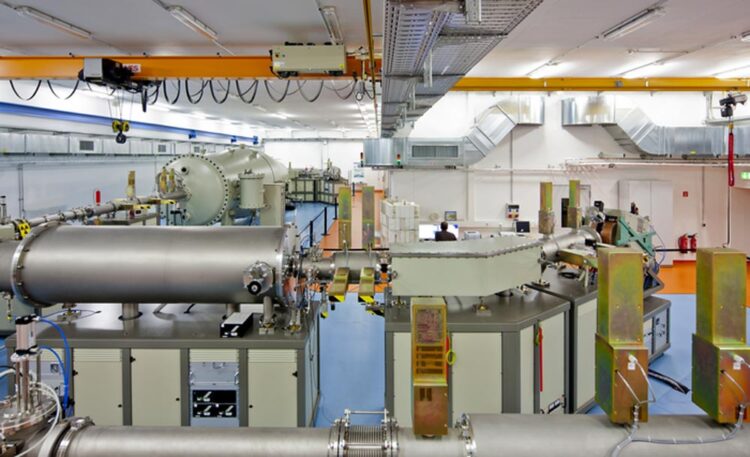A recycling hub for materials research

Accelerator at HZDR's Ion Beam Center
Credit: HZDR/Oliver Killig
The EU project ReMade@ARI starts on September 1st under the coordination of the HZDR.
According to the European Union’s Circular Economy Action Plan, the industry can determine up to 80 percent of a product’s subsequent environmental impact at the design phase. However, the linear manufacturing pattern offers few incentives to make products more sustainable. The research infrastructure project ReMade@ARI, which deals with innovative materials for key components in various areas such as electronics, packaging or textiles, wants to change this: The goal is to develop new materials with high recyclability and at the same time competitive functionalities. To this end, the institutions involved want to harness the potential of more than 50 analytical research infrastructures throughout Europe under the coordination of the Helmholtz-Zentrum Dresden-Rossendorf (HZDR).
An illustrative example: In the supermarket fruits and vegetables are often packaged in plastics to extend their shelf life. In future, bio-based materials derived from wood could provide a sustainable alternative. This is where ReMade@ARI comes into play: research leading to the development of such sophisticated new materials crucially relies on access to the world-class European research infrastructures, which joined forces in ReMade@ARI.
The ReMade@ARI platform will be the central hub for all sectors and research areas in which new materials for a circular economy will be developed. “We provide scientists who are working on the design of new recyclable materials with analytical tools that enable them to explore the properties and the structure of their material in smallest details up to atomic resolution. This requires the exploitation of the most diverse analytical methods, involving appropriate combinations of photons, electrons, neutrons, ions, positrons and the highest magnetic fields,” says Dr. Stefan Facsko, the project’s scientific coordinator. “Any scientist in academic or industrial research working on new recyclable materials should get in touch with us.”
A particular focus will be on scientists in research fields in which up to now, the potential of research infrastructures has not yet been exploited. “We will offer them an all-round service, closely collaborating with them to identify the relevant properties to be analyzed in order to develop the optimum material for a particular purpose. Based on that, the most suitable research infrastructures to measure these properties will be identified from among the pool of Europe’s unique facilities.”
ReMade@ARI will have a significant impact on the advancement of the circular economy. Overall, 40 partners of the ARIE network are involved in the project. HZDR alone is contributing three large-scale user facilities: the Ion Beam Center (IBC), the Dresden High Magnetic Field Laboratory (HLD) and the positron source at the ELBE Center for High-Power Radiation Sources (pELBE).
The project is being funded by the EU with a budget of 13.8 million euros. The project coordinator is HZDR.
Dr. Barbara Schramm, EU-Liaison Officer at HZDR, explains: “With a pool of highly motivated young researchers, the project will offer a user service of unprecedented quality which will enable each promising idea to be brought to success. We encourage in particular researchers from industry, for which we have put together an extensive package of support measures tailor-made to industry needs, to get in touch with us.”
Further information:
Dr. Stefan Facsko I Head
Ion Beam Center at HZDR
Phone: +49 351 260 2987 I Email: s.facsko@hzdr.de
Dr. Barbara Schramm I Head
Research Programs and International Projects at HZDR
Phone: +49 351 260 2684 I Email: b.schramm@hzdr.de
Media contact:
Simon Schmitt | Head
Department of Communication and Media at HZDR
Phone: +49 351 260 3400 | Mobile: +49 175 874 2865 | Email: s.schmitt@hzdr.de
The Helmholtz-Zentrum Dresden-Rossendorf (HZDR) performs – as an independent German research center – research in the fields of energy, health, and matter. We focus on answering the following questions:
• How can energy and resources be utilized in an efficient, safe, and sustainable way?
• How can malignant tumors be more precisely visualized, characterized, and more effectively treated?
• How do matter and materials behave under the influence of strong fields and in smallest dimensions?
To help answer these research questions, HZDR operates large-scale facilities, which are also used by visiting researchers: the Ion Beam Center, the Dresden High Magnetic Field Laboratory and the ELBE Center for High-Power Radiation Sources.
HZDR is a member of the Helmholtz Association and has six sites (Dresden, Freiberg, Görlitz, Grenoble, Leipzig, Schenefeld near Hamburg) with almost 1,500 members of staff, of whom about 670 are scientists, including 220 Ph.D. candidates.
Media Contact
Simon Schmitt
Helmholtz-Zentrum Dresden-Rossendorf
c.bohnet@hzdr.de
Office: 351-260-3400
Original Source
All latest news from the category: Materials Sciences
Materials management deals with the research, development, manufacturing and processing of raw and industrial materials. Key aspects here are biological and medical issues, which play an increasingly important role in this field.
innovations-report offers in-depth articles related to the development and application of materials and the structure and properties of new materials.
Newest articles

Innovative 3D printed scaffolds offer new hope for bone healing
Researchers at the Institute for Bioengineering of Catalonia have developed novel 3D printed PLA-CaP scaffolds that promote blood vessel formation, ensuring better healing and regeneration of bone tissue. Bone is…

The surprising role of gut infection in Alzheimer’s disease
ASU- and Banner Alzheimer’s Institute-led study implicates link between a common virus and the disease, which travels from the gut to the brain and may be a target for antiviral…

Molecular gardening: New enzymes discovered for protein modification pruning
How deubiquitinases USP53 and USP54 cleave long polyubiquitin chains and how the former is linked to liver disease in children. Deubiquitinases (DUBs) are enzymes used by cells to trim protein…



